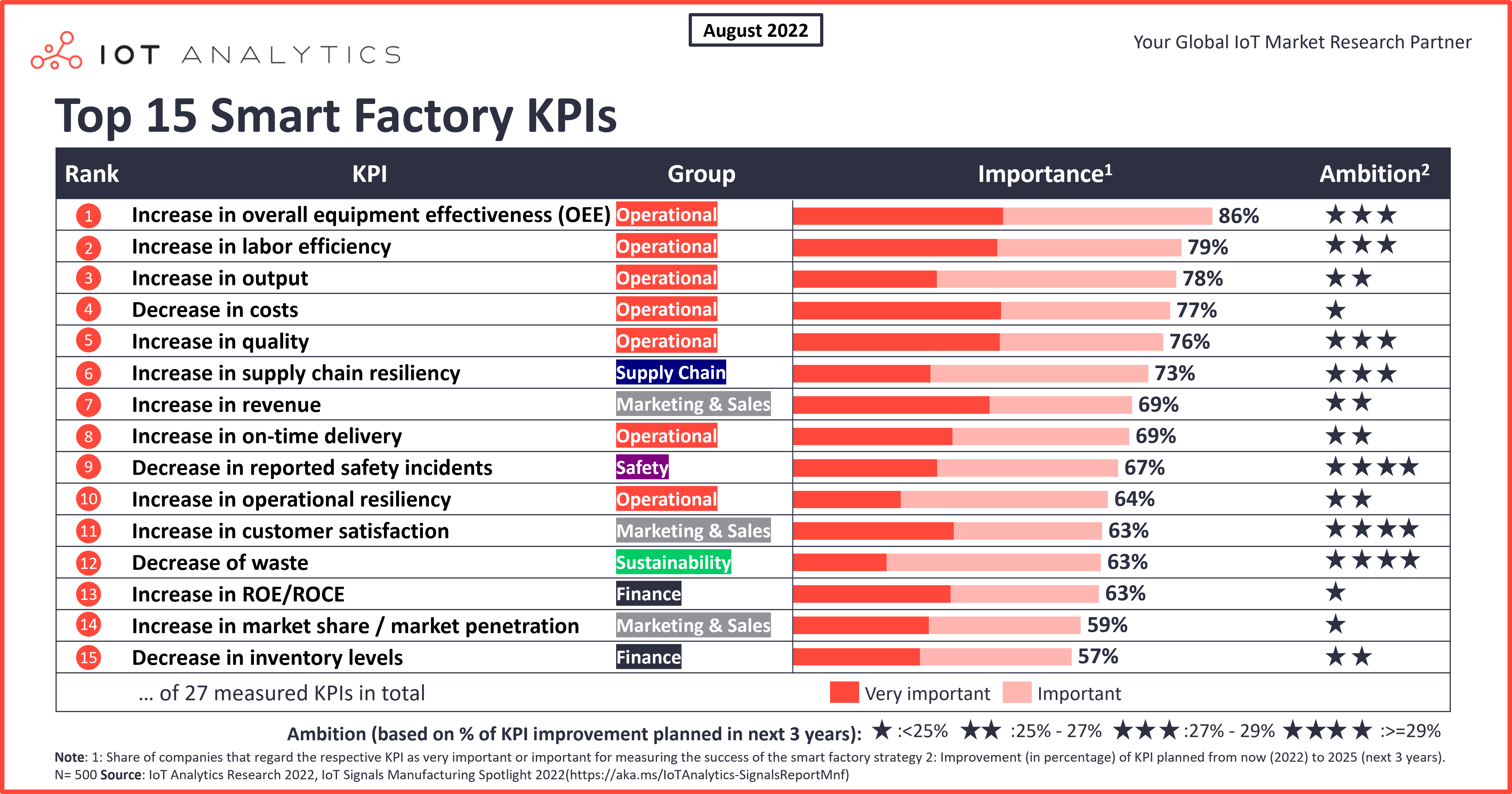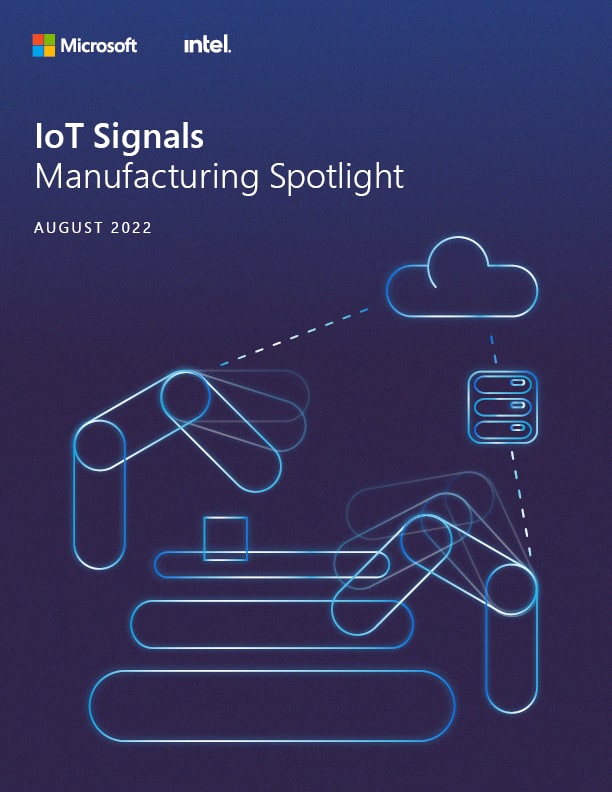
In short
- When evaluating the success of a smart factory, operational KPIs are important for manufacturers in all regions and industries and across all company sizes.
- Companies are ambitious to improve supply chain, safety, and sustainability KPIs in the next three years.
Why it matters
- For manufacturers: The data provide an opportunity to benchmark against industry peers.
- For technology vendors: Aligning services and products offered with the KPIs that manufacturers prioritize is important.
72% of manufacturers have partially or fully implemented a smart factory strategy today. Similarly, nearly two-thirds (65%) are in various stages of implementing their IoT strategy. Although the pandemic, looming recession, inflation, and global supply chain issues have been prevalent topics in the last year(s), manufacturers are determined to fast-track their digital transformation projects in the next three years.
With nearly three-quarters of manufacturers currently implementing a smart factory strategy, we were curious to find out what manufacturing KPIs are most important to measure the success of this transformation. We prompted the decision-makers with 27 different manufacturing KPIs and asked how important each one is for their smart factory project.
This is just one of many analyses of the 59-page IoT Signals Report – Manufacturing Spotlight (August 2022), published by Microsoft and Intel, with research conducted by IoT Analytics. As part of this research, IoT Analytics surveyed 500 decision-makers working in discrete, hybrid, or process manufacturing in April and May 2022 and conducted in-depth interviews with a subset of them.
This article highlights one of the many analyses from the report in further depth:
1. Most important operational KPI: Increase in OEE
All the top five manufacturing KPIs are related to operational goals. Across all regions and industries, respondents are highly focused on improving operational performance, including overall equipment effectiveness (OEE), labor efficiency, and output. The increase in OEE is the most important manufacturing KPI for measuring the success of their smart factory strategies. This KPI is seen as either important or very important by 86% of manufacturers.
Earlier research by IoT Analytics (view the blog post here) found that across all enterprises, smart operations use cases (e.g., remote asset monitoring, IoT-based process automation, or predictive maintenance) are leading ahead of smart supply chain use cases (e.g., fleet management) and smart product use cases (e.g., location tracking). The results are confirmed for manufacturing companies by the IoT Signals Report – Manufacturing Spotlight: Manufacturers are laser-focused on operations. In addition to improving OEE, 79% of manufacturers measure the increase in labor efficiency, 78% the increased output, 77% the decrease in costs, and 76% the increase in quality. All these KPIs can be improved by IoT use cases.
Smart factory example:
Bonfiglioli, an Italian power transmission component manufacturer, improved its productivity by a factor of four in its new EVO factory. The new plant features a series of IoT-based smart factory use cases. Production lines are semi-automated with collaborative robots to improve efficiency. Automated guided vehicles are used to transfer parts and feed material to assembly lines and machines. Digital twins of robots are directly integrated into MES systems to link production data. Real-time production status is tracked through dashboard visualizations displaying KPIs. Machining units are completely automated and connected in real-time to the cloud to monitor production and quality status.
2. Most important supply chain KPI: Increase supply chain resiliency
The increase in supply chain resiliency is regarded as important or very important for 73% of manufacturers. The global supply chain issues that were sparked by pandemic lockdowns and (trade) wars have put this manufacturing KPI in the spotlight of many factories. On average, the ambition of manufacturers is to increase supply chain resiliency by 28% in the next three years. Decision-makers see implementing new IoT based technology as a smart way to safeguard themselves from global turbulences.
Smart factory example:
BMW, a leading German automotive company, introduced a track and trace solution of parts using the cloud, RFID, and an IoT platform to ensure the matching of seat assembly with models in assembly. At all stages of the seat assembly, the RFID tags are continuously scanned and cross-referenced with the database information to reduce errors in assembling. A store specialist can use a smartphone app to track pre-series cars in production and validate features and configurations.
3. Most important safety KPI: Decrease in reported safety incidents
A decrease in reported safety incidents is regarded by 67% of manufacturers as an important manufacturing KPI in measuring the success of their smart factory strategy. And decision-makers want to act on it. The average ambition of manufacturers is to improve the KPI by 30% in the next three years. Safer employees are happier and more productive employees—not only during the current environment of labor shortage but also otherwise.
Smart factory example:
Kalbe Morinaga is the Indonesian nutritional division of the Kalbe group. The company has eliminated the need for manual inspection of filling machines in their plants, which used to be tedious and unsafe and took up to 10 minutes. The machine inspection was completely digitized by connecting the control system to the data server and then visualizing it in mobile and desktop applications—no human intervention is needed.
4. Most important marketing and sales KPI: Increase in revenue
For 69% of manufacturers, the increase in revenue is an important manufacturing KPI to measure the success of their smart factory strategy. The introduction of new IoT-based technologies does not only affect the operations themselves but also indirectly affects the revenue. Customers expect vendors in discrete and process industries to deliver high-quality, highly customized products on time.
Smart factory example:
Alibaba, the Chinese e-commerce giant, built its Xunxi factory for flexible, small-batch manufacturing that aids SMEs who cannot afford cutting-edge Industry 4.0 technologies. By utilizing automated guided vehicles, AI-based fabric cutting machines, automated sewing, and connecting everything to the cloud, the company could reduce the minimum order quantity by 98% and manufacturing lead time by 50%. Therefore, the company satisfies its SME customers who want smaller lot sizes and shorter lead times to react to fashion trends faster.
5. Most important sustainability KPI: Reduction of waste
Nearly two-thirds (63%) of manufacturers see the reduction of waste as an integral part of their smart factory transformation. Although sustainability improvements are not the main driver of smart factory strategies, manufacturers are devoting more attention to the topic and often see it as complementary to the existing operational KPIs. Respondents ranked “decrease in waste” as the manufacturing KPI with the second-highest overall ambition and “carbon footprint reduction” as the fastest-accelerating manufacturing KPI. This indicates that respondents recognize the opportunity for tangible improvements and are likely to boost the importance of sustainability KPIs in the coming years. Moreover, improving a sustainability KPI often correlates with improving an operational KPI and vice versa. For example, a reduction in energy usage or waste may lead to a reduction in costs, while an increase in process efficiency may lead to lower energy use and a better carbon footprint.
Smart factory example:
Kalbe Morinaga’s products are a combination of different nutrients in powder form. The operators are responsible for combining all the ingredients for a product according to the SOP. The company created a completely digitized flow using a database and QR codes to reduce errors. All the orders and respective compositions are tracked. The employees scan the QR code of each ingredient with their smartphone before feeding it to the blending machine. Each machine has a QR code as well, and a thread of production is created. If the codes do not match, the system alerts the user. This helps to reduce errors and consequently wasted materials too.
6. Most important finance KPI: Increase in ROE/ROCE
The increases in return on equity (ROE)/return on capital employed (ROCE) are mentioned by 63% of all companies as an important manufacturing KPI. ROE and ROCE are financial ratios used to evaluate a company’s profitability and capital efficiency. Or, to put it differently: The KPI measures how much net income is generated for the cost of an asset. Smart factories aimed at a more efficient production process are in a prime position to improve the ROE/ROCE.
Smart factory example:
Foxconn, the Chinese electronics manufacturer, equipped its Shenzhen factory with sensors all over the machines. The aggregated data allows the machine performance to be tracked in real-time. By aggregating historical data and using AI algorithms, machine failures are predicted well in advance, boosting equipment efficiency by 17%. Moreover, the algorithms were designed for self-optimization for minor issues using machine learning technology.
7. Other notable findings
Not all respondents see the same KPIs as important, though. IoT Analytics’ previous research found that a smart factory’s production characteristics are largely responsible. The realization of a smart factory concept in a high-variety, high-volume discrete manufacturing automotive plant will be very different from that of a low-variety, high-volume process-based oil refinery. While the automotive plant may focus more on goals such as increasing output and product quality, the oil refinery may prioritize improving worker safety and optimizing energy usage.
Interested to learn more about the research?
IoT Signals Report – Manufacturing Spotlight (August 2022)
This report has been published by Microsoft and Intel, with the research for the report conducted by IoT Analytics.
| A definition of smart factory:
“The holistic transformation of people, processes, and enabling technologies along with the use of data to achieve the intended performance/business goals of one or more production site(s).”
Are you interested in learning more about smart manufacturing?
Related publications
You may be interested in the following publications:
- Smart Factories Insights Report 2021
- Industry 4.0 & Smart Manufacturing Adoption
- Virtualization in Industrial Automation | Adoption Report 2021
- Industrial IoT and Industry 4.0 Case Study Report 2022
Related articles
You may also be interested in the following recent articles:
- What are smart factories? 7 misconceptions and a definition
- Industry 4.0 Adoption 2020 – who is ahead?
- Soft PLCs: Revisiting the industrial innovator’s dilemma
- The top 10 industrial software companies
Are you interested in continued IoT coverage and updates?
Subscribe to our newsletter and follow us on LinkedIn and Twitter to stay up-to-date on the latest trends shaping the IoT markets. For complete enterprise IoT coverage with access to all of IoT Analytics’ paid content & reports including dedicated analyst time check out the Enterprise subscription.


